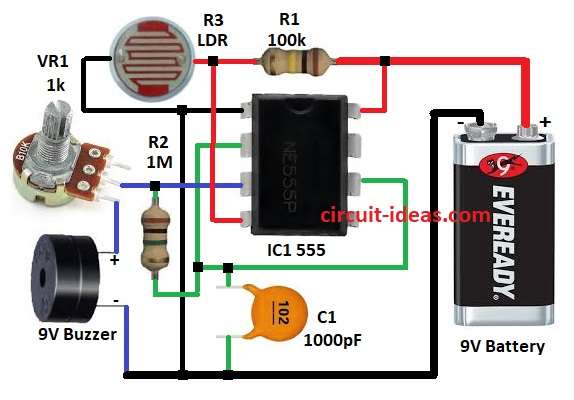Simple Dark Sensor Circuit with Buzzer is a very easy project to make.
It detect no light and makes sound.
It is uses in night lights, security and alarms.
Circuit works with LDR, 555 timer and buzzer.
Low light makes buzzer ON.
This circuit runs on 9V battery which is small and handy.
Circuit Working:

Parts List:
| Component | Specification | Quantity |
|---|---|---|
| Resistors (All resistors are 1/4 watt unless specified) | 100k | 1 |
| 1M | 1 | |
| Potentiometer 1k | 1 | |
| LDR | 1 | |
| Capacitors | Ceramic 1000pF | 1 |
| Semiconductors | IC 555 Timer | 1 |
| Buzzer 9V Buzzer | 1 | |
| Power Supply 9V Battery | 1 |
Simple dark sensor uses IC 555 timer in bistable mode.
LDR and resistor R1 make voltage divider for reset pin 4.
When there is light LDR is with low resistance the reset pin is high and is circuit OFF.
And when it is dark the LDR is with high resistance then reset pin voltage is low and buzzer is ON.
VR1 pot control current from pin 3 to protect buzzer.
R3 LDR is low resistance in light with 1k to 10kΩ and is high in dark with 100k to 1MΩ.
This change affects trigger pin 2 to turn circuit ON when dark.
Capacitor C1 filter noise and stop false trigger and keep circuit smooth.
Formulas with Calculations:
Voltage divider rule:
V_LDR = 9V × (R2 / (R2 + R3))
where,
- R2 is the 1MΩ fixed resistor
- R3 is the LDR resistance change with light.
555 timer trigger voltage:
V_trigger = 9V ÷ 3 = 3V
Timer triggers if pin 2 voltage < 3V.
LDR resistance:
In light LDR is 1kΩ to 10kΩ
In dark LDR is 100kΩ to 1MΩ
Voltage across LDR in light:
If LDR is 10kΩ then,
V_LDR_light = 9V × (1MΩ / (1MΩ + 10kΩ)) = 8.91V
More than 3V the timer will go OFF.
Voltage in dark:
If LDR is 500kΩ then,
V_LDR_dark = 9V × (1MΩ / (1MΩ + 500kΩ)) = 6V
Still above 3V then there is no alarm.
At full dark (LDR = 1MΩ):
V_LDR_dark = 9V × (1MΩ / (1MΩ + 1MΩ)) = 4.5V
Still > 3V then there is no alarm yet.
To activate earlier make R2 smaller so trigger voltage is lower.
How to Build:
To build a Simple Dark Sensor Circuit with Buzzer following steps are required to be followed for connections of the circuit:
- Pin 1 IC1 connects to GND
- Pin 2 IC1 goes to pin 6 IC1
- C1 goes between pin 2 IC1 and GND
- R2 goes between pin 2 IC1 and pin 3 IC1
- Pin 3 IC1 connects to VR1 pot, buzzer and then GND
- Pin 4 & pin 8 of IC1 connects to +9V battery
- R1 connects between pin 4 and pin 8 IC1
- LDR R3 connects to one end of +9V battery and other end goes to GND
Conclusion:
This Simple Dark Sensor Circuit with Buzzer is easy to make and is good to warn in dark.
It change resistors to make more or less sensitive.
The circuit is used for alarms, night lights, automatic light switch to save energy.
Leave a Reply